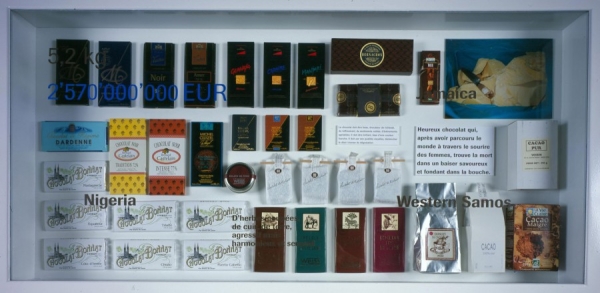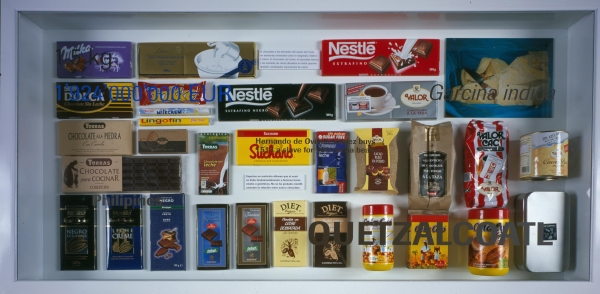
Installation view, Galerie Christian Nagel, Cologne
Detail, “A Taste for Money — France,” 2002
Detail, “A Taste for Money – Spain,” 2002
Detail, “A Taste for Money – Ireland,” 2002
A Taste for Money
8 March – 20 April 2002
Galerie Christian Nagel, Cologne, Germany
Twelve display cases, MDF, painted; glass, adhesive letters, chocolate, cocoa, plaques with text; each 35 x 55 x 27 inches
– “A Taste for Money – Belgium,” 2002; collection of Eduard Zapp, Düsseldorf
– “A Taste for Money – Germany,” 2002; private collection, Berlin
– “A Taste for Money – Finland,” 2002
– “A Taste for Money – France,” 2002
– “A Taste for Money – Greece,” 2002
– “A Taste for Money – Ireland,” 2002
– “A Taste for Money – Italy,” 2002
– “A Taste for Money – Luxemburg,” 2002
– “A Taste for Money – Netherlands,” 2002
– “A Taste for Money – Austria,” 2002
– “A Taste for Money – Portugal,” 2002
– “A Taste for Money – Spain,” 2002
“The Sweetest Place on Earth,” 2001, MDF, painted, glass, adhesive letters, paint, photographs, five wall boxes, 9.75 x 622.25 x 5.5 inches; private collection, Berlin
Courtesy of Galerie Christian Nagel, Cologne / Berlin
In conjunction with the introduction of the Euro, Christian Philipp Müller used the chocolate manufacturing industry to develop a portrait of the European economic union. In twelve white vitrines, he displayed a selection of chocolate bars and cocoa packages sold in countries entering the European monetary union. The design of the chocolate and cocoa packages ranged from scanty to extravagant, with the merchandise aesthetic standing in direct relation to the gross national product of the corresponding Euro country. In addition, each of the vitrines also displayed a photograph of cocoa butter, the raw material for chocolate, which according to new European regulations could be replaced by substitute products. Blue lettering on the glass covers of the vitrines provided information about the European monetary union as well as each of the participating countries. Texts printed in brown gave both scientific information and unproven, popular wisdom about the effects of chocolate as well as the annual national consumption of each country, and a list of countries exporting cocoa beans. On the wall, Müller installed “The Sweetest Place on Earth,” a five-part text object consisting of white glazed boxes each printed with a single word. The boxes also showed views of the American city of Hershey, Pennsylvania, whose economy revolves solely around the production and sale of the choco-late bearing its name.
Müller used chocolate, a sensual object, to embody the drive towards uniformity in European policy, transforming the characteristics of this luxury commodity into mathematical quantities through seemingly endless lists and statistical analyses. Müller’s “A Taste for Money” transferred the notion of “taste” into the realm of recent economic policy.


